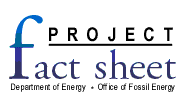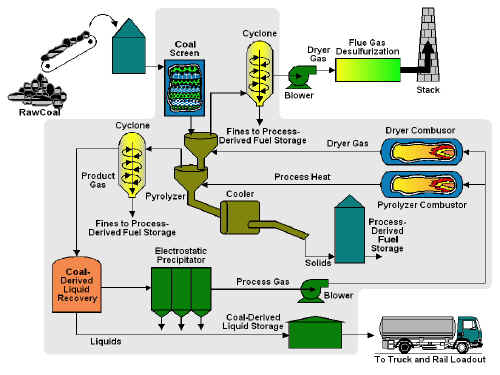
 |
ENCOAL® Mild Coal Gasification ProjectCoal Processing for Clean Fuels
|
|
| |
|
Participant Location Plant Capacity/Production Technology Coal |
|
Additional Team Members | |||||||
| |||||||||
|
ENCOAL, LFC, CDL, and PDF are registered trademarks of SGI and Bluegrass | |||||||||
 Project Objective
Project Objective
To demonstrate the integrated operation of a number of novel processing steps to produce two higher-value fuel forms from mild gasification of low-sulfur subbituminous coal and to provide sufficient products for potential end users to conduct burn tests.
Technology/Project Description
Coal is fed into a rotary grate dryer where it is heated to reduce moisture. The temperature is controlled so that no significant amounts of methane, CO2 , or CO are released. The solids are then fed to the pyrolyzer, where the temperature is about 1,000 °F, and all remaining water is removed. A chemical reaction releases the volatile gaseous material. Solids exiting the pyrolyzer are quenched to stop the pyrolysis reactions.
In the original process, the quench table solids were further cooled in a rotary cooler and transferred to a surge bin. A single 50% flow rate vibrating fluidized-bed (VFB) was added to stabilize the Process-Derived Fuel (PDF®) with respect to oxygen and water. In the VFB, the partially cooled, pyrolyzed solids contact a gas stream containing a controlled amount of oxygen. Termed "oxidative deactivation," a reaction occurs at active surface sites in the particles reducing the tendency for spontaneous ignition.
Following the VFB, the solids are cooled to near atmospheric temperature in an indirect rotary cooler where water is added to rehydrate the PDF® . A patented dust suppressant is added as the PDF® leaves the surge bin. The hot gas produced in the pyrolyzer is sent through a cyclone for removal of the particulates and then cooled in a quench column to stop any additional pyrolysis reactions and to condense the Coal-Derived liquid (CDL®)
Results Summary
Environmental
-
The product fuels have been used economically in commercial boilers and furnaces and have reduced SO2 and NOx emissions significantly at utility and industrial facilities currently burning high-sulfur bituminous coal or fuel oils.
-
One utility reported a 20% reduction in NOx emissions due to a more stable flame when burning PDF® .
-
The PDF® contains 0.36% sulfur with a heat content of 11,100 Btu/lb (compared to 0.45% sulfur and 8,300 Btu/lb for the feed coal).
-
The CDL® contains 0.6% sulfur and 140,000 Btu/gal (compared to 0.8% sulfur and 150,000 Btu/gal for No. 6 oil).
-
No EPA listed toxins in concentrations anywhere close to federal limits.
Operational
-
Almost five years of operating data have been collected for use as a basis for the evaluation and design of a commercial plant.
-
Numerous runs exceeding 120 days operation at 90% availability.
-
As of July 1997, about 260,000 tons of coal had been processed into 120,000 tons of PDF® and 5,101,000 gallons of CDL® .
-
Over 83,500 tons of PDF® have been shipped via 17 unit trains and 1 truck shipment to seven customers in six states. Blends have ranged from 20-100% PDF® .
-
Over 200 tank cars of CDL® have been shipped to eight customers in seven states. The largest customer has purchased 101 tank cars and blended the CDL® with its fuel and burned the mixture for process heat.
-
PDF® has been tested as a reductant (combined with iron ore) in the direct reduced iron process, and holds promise as a blast furnace injectant.
Economic
-
A commercial plant designed to process 15,000-metric-ton/day would cost $475 million (2001 $) to construct with annual operating and maintenance costs of $52 million per year.
Project Summary
Operational
A summary of plant performance is contained in Exhibit 5-41. ENCOAL's first 24-hour run took place in June 1992.
| ||||||||||||||||||||||||||||||||||||||||||||||||||||||||||||||||||||||||||||||||||||||||||||||||
After startup, it became evident that additional processing of the PDF® was necessary. Initially, the PDF® was "finished" by a short exposure to atmospheric conditions in a layered stockpile prior to be reclaimed and shipped, or either blended with run-of-plant PDF® , ROM coal, or the atmosphere stabilized PDF® , but there was a Btu penalty. After considering several alternatives, the VFB was added as part of the deactivation loop.
The VFB was designed to handle only half the ENCOAL plant's designed capacity; when proven, a second VFB was to be installed. Operations became notably smoother and more productive. This was attributable not only to the VFB's improved stabilization of the PDF® and the subsequent increased ease of handling, but also to the replacement of the pyrolyzer sand seal with a water seal and the installation of the process water fines handling system. All these improvements combined to produce a major landmark when ENCOAL® shipped its first train containing PDF® on September 17, 1994 to Western Farmers Electric Cooperative in Hugo, Oklahoma.
ENCOAL met all its goals for its first shipments of PDF® in the Fall of 1994— to demonstrate its ability to coordinate with the Buckskin Mine in loading and shipping consistent blends, to ship PDF® with dust generation comparable to or less than run-of-mine (ROM) Buckskin coal, and to ship PDF® blends that were stable with respect to self heating. Furthermore, ENCOAL demonstrated that PDF® could be transported and delivered to customers using regular commercial equipment. With respect to use, the goal was for customers to burn trial amounts (˝ unit train minimum) of PDF® blends with minimal adjustment of equipment. ENCOAL's test burn shipments became international when Japan's Electric Power Development Company evaluated six metric tons of PDF® in 1994. Early 1995 saw much increased plant volume when 13,700 tons of raw coal were processed in a one-month period. Plant availability reached 89%, with downtime attributable to the replacement of the original quench table heat exchanger with a new, high capacity unit.
ENCOAL began shipping unit trains of 100 PDF® for the first time in 1996. By the end of October, two 100 PDF® unit trains were delivered to two separate utilities for test burns. The first was burned in Indiana-Kentucky Electric Cooperative's Clifty Creek Station, which is jointly owned by American Electric Power. The PDF® was blended with Ohio high-sulfur coal at the utility and burned in the Babcock & Wilcox open-path, slag-tap boiler with full instrumentation. Blends tested ranged between 70 and 90% PDF® , and burn results indicated that even with one pulverizer out of service, the unit capacity was increased significantly relative to the base blend. More importantly, there was at least a 20% NO x reduction due to a more stable flame. Completion of this test burn achieved a primary project milestone of testing PDF® at a major U.S. utility. The remaining 100% PDF® unit train was sent to Northern Indiana Public Service Company and to Union Electric's Sioux Plant near St. Louis, Missouri.
The largest user of the CDL® was Dakota Gas, which purchased 101 tank cars. Dakota Gas blended the CDL® with its fuel and burned the mixture for process heat. A thorough characterization of the CDL® was done by Dakota Gas, for ENCOAL. Tests with a centrifuge successfully removed much of the sediment in the CDL® .
By the end of July, 1997, about 260,000 tons of coal had been processed into 120,000 tons of PDF® and 5,101,000 gallons of CDL® . Over 83,500 tons of PDF® had been shipped to seven customers in six states, as well as 203 tank cars of CDL® to eight customers in seven states.
Stabilization of the PDF® presented challenges to the engineers at ENCOAL. Over 20 different operating conditions were evaluated to enhance the amount of oxygen absorbed in the VFB system. However, VFB deactivation was not complete—stabilization still involved "finishing" using pile layering as well as blending with ROM coal, increased silo retention time, and higher rehydration. This "pile layering" allows the PDF® to react with oxygen and become stable, but is labor intensive and negatively impacts PDF® quality. A stabilization task force composed of private and government engineers and scientists recommended the construction and testing of a Pilot Air Stabilization System (PASS) to complete the oxidative deactivation of PDF® without drying the product. The design and installation of the PASS was completed in November 1995 and the unit operated successfully from November 1995 to January 1996. The PASS processed ˝ to 1 ton of solids per hour, 24 hours per day, for 2˝ months producing a stable PDF® that could be stored in uncompacted piles without pile layering.
Environmental
Environmental compliance was an important goal during the demonstration of the LFC® process. Five significant environmental modifications were made at the ENCOAL facility.
Extensive ambient air monitoring work revealed no EPA listed toxins in concentrations anywhere close to federal limits. It was decided, however, to install a vapor recovery system on all process water holding vessels to address an odor problem.
Economic
The "base case" for economics of a commercial plant is the 15,000-metric-ton/day, three-unit North Rochelle LFC® plant, the commercial scale plant proposed by ENCOAL® , with an independent 80-MW cogeneration unit, and no synthetic fuel tax credit (29c tax credit). It is assumed that the cogeneration unit is owned and operated by an independent third-party. The capital cost for a full scale three module LFC® plant is $475 million.
Economic benefits from an LFC® commercial plant are derived from the margin in value between a raw, unprocessed coal and the upgraded products, making an LFC® plant dependent on the cost of feed coal. In fact, this is the largest single operating cost item. The total estimated operating cost is $9.00/ton of feed coal including the cost of feed coal, chemical supplies, maintenance, and labor.
A financial model was constructed using a spreadsheet to evaluate the project's financial viability. The unleveraged Internal Rate of Return (IRR) on the base case of around 15% is encouraging given the project's upfront capital requirements, long construction period, and 30-year project life. The project generates impressive after-tax cash flows (ATCF's) with payback on the base case of less than nine years from plant startup and cumulative ATCF's over 30 years, exceeding $2 billion.
The probability of reaching the 18-20% range for IRR is good, given a combination of lower capital costs and increased revenues. An increase in revenue of 10% coupled with a decrease in capital cost of 10% would provide an unleveraged IRR in excess of 18%.
A possible upside to the base case is use of the non-conventional fuel tax credit commonly referred to as 29c. The addition of 29c to the base case evaluation adds over 15% to the unleveraged IRR, and more than doubles the project net present value.
Commercial Applications
AEI Resources, a unit of Addington Enterprises of Ashland, Kentucky, through its 1998 acquisition of Zeigler Coal Holding Co., holds an undivided and equal interest in the LFC® technology along with SGI International. AEI Resources is the administrative partner responsible for preparation of lease agreements and contracts. In order to determine the viability of potential LFC® plants, five detailed commercial feasibility studies—two Indonesian, one Russian, and two U.S. projects—have been completed. Permitting of a 15,000 metric-ton/day commercial plant in Wyoming is nearly complete.
Contacts
J.P. Fredrick
ENCOAL® Corporation
P.O. Box
3038
Gillette, WY 82717
(307) 686-2720
(307) 686-2894 (fax)
jfrederick@vcn.com
Douglas Archer, DOE/HQ, (301) 903-9443 douglas.archer@hq.doe.gov
Douglas M. Jewell, NETL, (304) 285-4720 mailto:djewel@fetc.doe.gov

